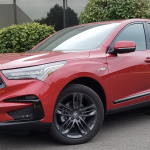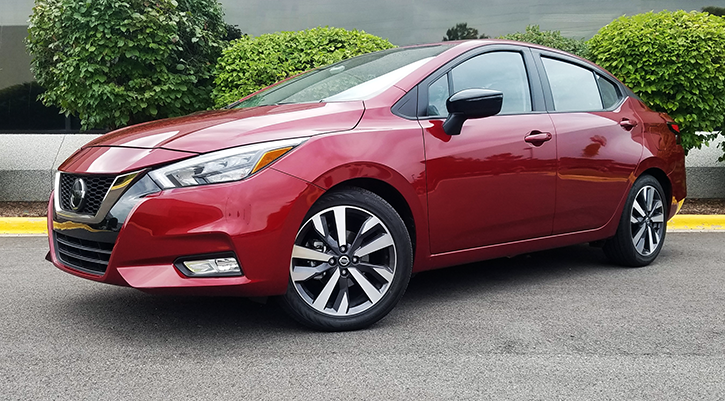
 2020 Nissan Versa SR
2020 Nissan Versa SR
Class: Compact Car
Miles driven: 293
Fuel used: 9.9 gallons
| CG Report Card | |
|---|---|
| Room and Comfort | A- |
| Power and Performance | C+ |
| Fit and Finish | B- |
| Fuel Economy | B- |
| Value | A |
| Report-card grades are derived from a consensus of test-driver evaluations. All grades are versus other vehicles in the same class. Value grade is for specific trim level evaluated, and may not reflect Consumer Guide's impressions of the entire model lineup. | |
| Big & Tall Comfort | |
| Big Guy | B |
| Tall Guy | B |
| Big & Tall comfort ratings are for front seats only. "Big" rating based on male tester weighing approximately 350 pounds, "Tall" rating based on 6'6"-tall male tester. | |
| Drivetrain | |
| Engine Specs | 122-hp 1.6L |
| Engine Type | 4-cylinder |
| Transmission | CVT automatic |
| Drive Wheels | Front-wheel drive |
Real-world fuel economy: 29.6 mpg
Driving mix: 60% city, 40% highway
EPA-estimated fuel economy: 32/40/35 (city, highway, combined)
Fuel type: Regular gas
Base price: $18,240 (not including $895 destination charge)
Options on test vehicle: Convenience Package ($300), premium paint ($395), floor mats ($210)
Price as tested: $20,040
Quick Hits
The great: Bargain pricing; excellent level of features and all-around refinement for the money
The good: Attractive styling; SR model comes standard with a generous list of high-tech safety gear
The not so good: Luxury/convenience features such as a sunroof, leather upholstery, or power seats aren’t available
More Versa price and availability information
John Biel
Nissan can always improve on the Versa as a car—and it does for 2020. What may be impossible is improving on it as an idea.
As Consumer Guide noted in its First Spin post about the new generation of this small sedan, it issues from a hereditary line that frequently boasted the lowest-priced car on the market. That point is interesting enough on its own, but it’s almost astounding that the Versa did this as a member of the compact class, not the smaller subcompact group. It doesn’t hold that distinction for ’20, but it offers much more car for what’s still not a lot of money, so it remains an excellent value.
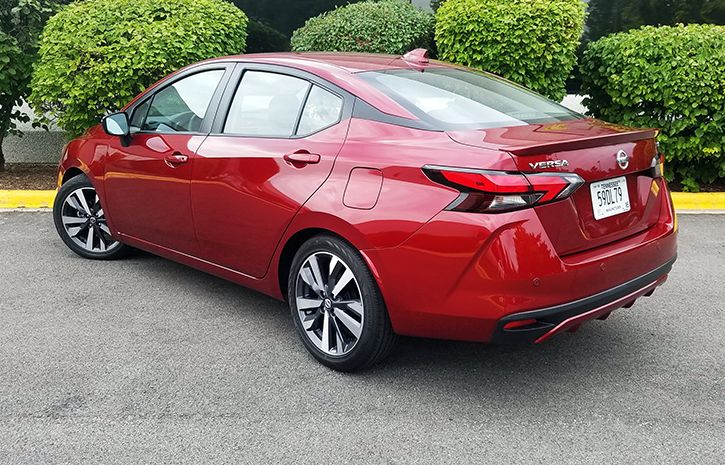
The Versa is a little longer and wider than before, and it’s lower too. There’s more power, and the list of standard safety features grows to include some that are new to the model line—and rare for the class. The entry-level S model can be had for as little as $15,625 with delivery, but even the top-grade SR that CG editors tested starts at $19,135. Adding on extra-cost Scarlet Ember paint, floor and trunk mats, and a package with “Intelligent” cruise control and heated front seats, the test car barely exceeded the $20,000 mark.
By the time a Versa gets to the SR level, it has already accumulated automatic emergency braking with pedestrian detection, rear automatic braking, lane-departure warning, blind-spot warning, rear cross-traffic alert, and a driver-alertness monitor on the safety side. Conveniences count a NissanConnect infotainment system with 7-inch touchscreen display, Apple CarPlay/Android Auto smartphone compatibility, and satellite radio; rear-door alert (as a reminder to check the back seat upon exiting the car); headlight high-beam assist; flip-down driver’s-seat inboard armrest; tilt and telescoping steering column; keyless entry and starting; and heated exterior mirrors with LED turn-signal indicator.
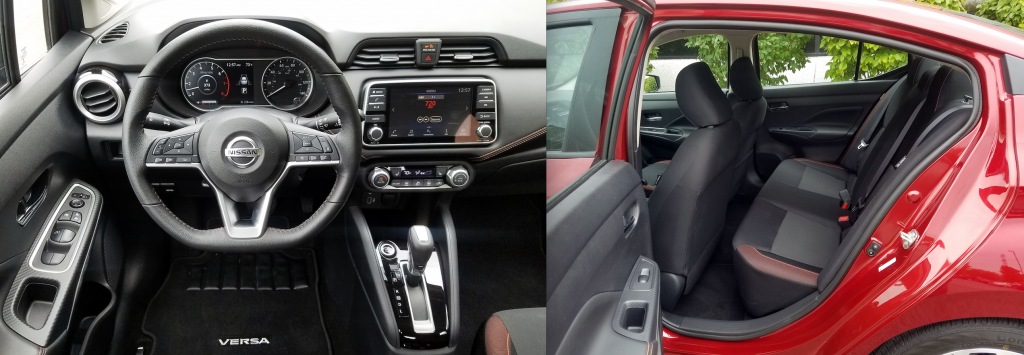
External SR specifics are 17-inch 5-spoke alloy wheels, a dark-chrome grille, LED headlights and daytime running lights, fog lights, and body-color rear spoiler. The cabin is augmented by patterned “sport” cloth seat trim, leather-wrapped steering wheel and shifter knob, remote engine-start system, automatic climate control, and 6-speaker audio.
As before, the 2020 Nissan Versa is motivated by a 1.6-liter 4-cylinder engine. Where it previously made 109 horsepower and 107 lb-ft of torque it now generates 122 horsepower at 6000 rpm and 114 lb-ft at 4400 rpm. An automatic continuously variable transmission (CVT) is standard in SV and SR models, but a 5-speed manual is standard in the S, with the CVT available. The powerteam is adequate—you’ll be safe on the highway with it—but it’s no source of excitement. The CVT is pretty quiet in operation, but only enables speed to build gradually.
EPA fuel-economy estimates for the 1.6 with CVT are 32 mpg in city driving, 40 on the highway, and 35 mpg for combined operation. However, this driver notched just 29.49 mpg after putting 184 miles on the test car, 65 percent of that in city-style conditions.
Test Drive: 2019 Mazda 3 Sedan
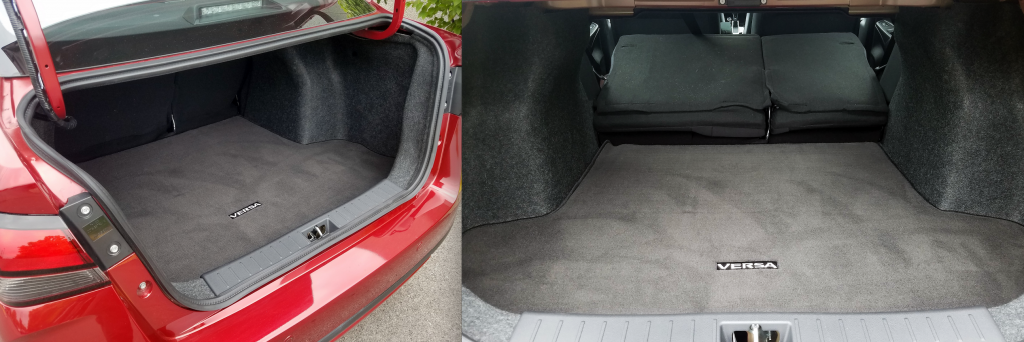
In terms of driving character, steering may be the most impressive part of the chassis. The electrically power-assisted steering feels nicely weighted, and displays fairly good response to inputs. The Versa stops and manages bumps pretty well, too.
The cabin doesn’t seem to be all that wide across, but there’s sufficient leg- and headroom for most builds. Rear seat backs are a little on the upright side, but not uncomfortably so. A couple of 6-footers might just sit front to back, though headroom won’t be as accommodating for the rear passenger in that scenario—this 5-foot-10.5 tester didn’t have a lot of overhead space left when he sat there. Front and rear-outboard seats are comfortable and provide good support. There’s a little bit of a flat-topped floor hump, but the reviewer was able to sit in the middle with his knees just clear of the front seat backs, so under the right conditions a third adult might make it in for short hops.
Entries and exits are easy through all doors. External styling has hints of Nissan’s “flying roof” motif found on its larger sedans, but with more compact dimensions, Versa’s roof can’t slope as much, so the it doesn’t suffer driver-vision obstructions to the same degree the Maxima and Altima do.
Test Drive: 2020 Toyota Corolla XSE
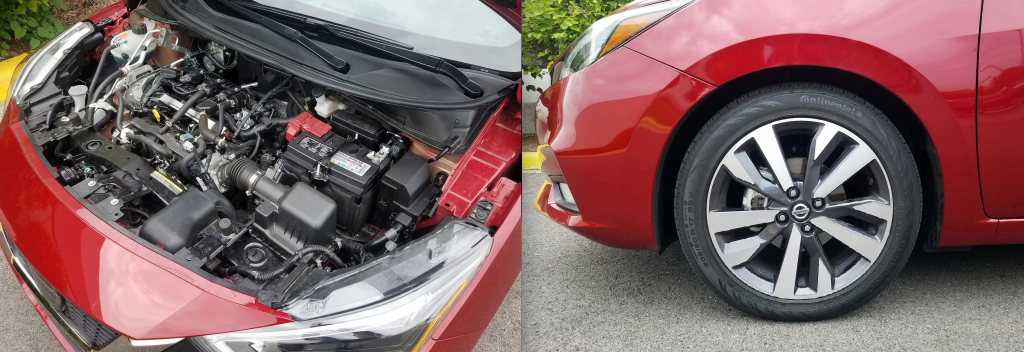
Even as an SR, the Versa is not much for plush. The dash is faced with thinly padded vinyl, and soft-to-the-touch material barely covers the armrests and door centers. Otherwise there‘s a lot of hard plastic. At least the SR has a leather-wrapped steering wheel and shifter knob, and its fabric seats have sewn-in copper highlights that match the contrast stitching on the steering wheel, dash, and armrests. This simplicity extends to the audio and climate controls, the latter of which uses separate temperature and fan-speed dials for quick selection. A true “pivoting-needle” analog speedometer dial is paired with a virtual analog tachometer and vehicle-information display.
Front storage consists of a useful glove box; an open tray at the front of the console that’s close to auxiliary, USB, and 12-volt-power inputs; large door pockets with bottle holders; and exposed cup holders in the console. Rear storage comes down to bottle holders in the doors, a pouch on the back of the front passenger seat, and a small open cubby at the back of the console.
Trunk space is pretty good for a small car. There’s a low liftover to clear a modest lip. The tall, squared-off cargo space narrows some between the wheel houses, and gooseneck decklid hinges intrude into the space. A mini spare tire almost seems lost in the spare-tire well, but that leaves lots of room for informal underfloor storage. The rear seat backs fold in a 60/40 divide. They rest almost flat but at a considerable height above the trunk floor, which will complicate loading of long items.
All in all, the new Nissan Versa is not a bad car for the money—especially for the money.
Test Drive: 2019 Hyundai Elantra Limited

Test Drive: 2019 Toyota Yaris XLE
2020 Nissan Versa

